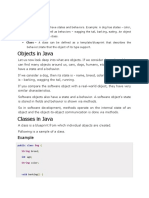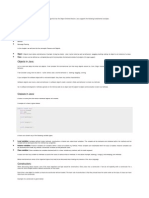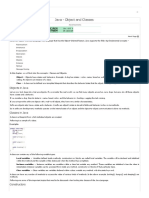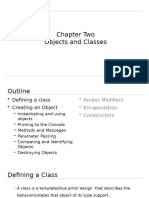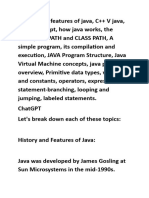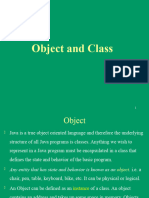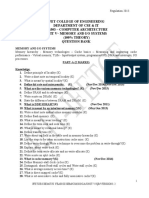Module 2 Getting To Know Java and Object Oriented Programming
Uploaded by
Kahrl CerinModule 2 Getting To Know Java and Object Oriented Programming
Uploaded by
Kahrl CerinCollege for Research & Technology of
Cabanatuan
Burgos Avenue, Cabanatuan City 3100
Tel. 463-2735 463-2697 600-2200 e-mail: crt.cabanatuan@gmail.com
Lesson Title: Getting to know Java and Object-Oriented Programming
Lesson Objectives:
At the end of this module, you should be able to:
1. Understand the different concepts relevant to object model.
Reference: https://www.tutorialspoint.com/java/index.htm
Productivity Tip: To commence this academic year, may this quote of George Raymond Richard Martin
inspire and fuel your drive to learn, and be more in your chosen field; despite of the crisis you are all facing.
May you thrive and crave for self-improvement through EDUCATION, amidst of uncertainties.
“I’m a slow learner, it’s true. But I learn.”
A. LESSON PREVIEW/REVIEW
1. Introduction
- Java is an Object-Oriented Language. As a language that has the Object-Oriented feature, Java
supports the following fundamental concepts – Polymorphism, inheritance, encapsulation,
abstraction, classes, objects, instance, method, and message passing.
- Objects- have states and behavior. It is an instance of a class. For example, A dog has states –
color, name, breed, and behaviors – wagging the tail, barking, eating.
- Class – can be defined as a template, blueprint that describes the behavior/state that the
object of its type support.
2. Activity 1: What I Know Chart (PART 1)
For today’s lesson try answering the questions below fill out the first column of the table. Write
your idea about the questions being asked in “What I know” part. It’s okay to write what came
out to your mind after reading the questions.
What I Know Questions: What I Learned (Activity 4)
1. What is object in Java?
2. What is class in Java?
College for Research & Technology of
Cabanatuan
Burgos Avenue, Cabanatuan City 3100
Tel. 463-2735 463-2697 600-2200 e-mail: crt.cabanatuan@gmail.com
B. MAIN LESSON
1. Activity 2: Content Notes
Objects in Java
Objects also have a state of behavior. An object’s state is stored in fields and behavior is shown
via methods. So in software development, methods operate on the internal state of an object and the
object-object communication is done via methods. An object is created from a class. In Java, the new
keyword is used to create new objects.
There are three steps when creating an object from a class
1. Declaration – a variable declaration with a variable name with an object type.
2. Instantiation – the ‘new’ keyword is used to create the object.
3. Initialization – the ‘new’ keyword is followed by a call to a constructor. This call initializes the new
object.
Example:
public class Puppy {
public Puppy(String name) {
// This constructor has one parameter, name.
System.out.println("Passed Name is :" + name );
}
public static void main(String []args) {
// Following statement would create an object myPuppy
Puppy myPuppy = new Puppy( "tommy" );
}
}
Output:
Passed Name is: tommy
Accessing Instance Variables and Methods
Instance variables and methods are accessed via created objects. To access an instance variable, following is
the fully qualified path −
/* First create an object */
ObjectReference = new Constructor();
College for Research & Technology of
Cabanatuan
Burgos Avenue, Cabanatuan City 3100
Tel. 463-2735 463-2697 600-2200 e-mail: crt.cabanatuan@gmail.com
/* Now call a variable as follows */
ObjectReference.variableName;
/* Now you can call a class method as follows */
ObjectReference.MethodName();
Classes in Java
A class is a blueprint from which individual objects are created. A class can contain any of the following
variable types.
• Local variables – this are variables defined inside methods, constructors or blocks. The variable will be
declared and
initialized within the method and the variable will be destroyed when the method has completed.
• Instance variables − Instance variables are variables within a class but outside any method. These
variables are initialized
when the class is instantiated. Instance variables can be accessed from inside any method, constructor or
blocks of that
particular class.
• Class variables − Class variables are variables declared within a class, outside any method, with the static
keyword.
A class can have any number of methods to access the value of various kinds of methods. In the above
example, barking(),
hungry() and sleeping() are methods.
Constructor- Every class has a constructor. The main rule of constructor is that they should have the same
name as class. Each time a new object is created, at least one constructor will be invoked.
Example 1
public class Puppy {
public Puppy() {
}
public Puppy(String name) {
// This constructor has one parameter, name.
}
}
College for Research & Technology of
Cabanatuan
Burgos Avenue, Cabanatuan City 3100
Tel. 463-2735 463-2697 600-2200 e-mail: crt.cabanatuan@gmail.com
Example 2
Public class MyClass;
Int num;
MyClass();
num=100;
{
}
You would call constructor to initialize objects as follows:
public class ConsDemo{
public static void main(String args[]){
MyClass t1=new MyClass();
MyClass t2=new MyClass();
System.out.printIn(t1.num+””+t2.num);
}
}
Output:
100 100
2. Activity 3: Skill- Building Activities
Let’s Practice! What is the output of the following Java codes? Write your answer in the box
below.
public class Puppy {
int puppyAge;
public Puppy(String name) {
// This constructor has one parameter, name.
System.out.println("Name chosen is :" + name );
}
College for Research & Technology of
Cabanatuan
Burgos Avenue, Cabanatuan City 3100
Tel. 463-2735 463-2697 600-2200 e-mail: crt.cabanatuan@gmail.com
public void setAge( int age ) {
puppyAge = age;
}
public int getAge( ) {
System.out.println("Puppy's age is :" + puppyAge );
return puppyAge;
}
public static void main(String []args) {
/* Object creation */
Puppy myPuppy = new Puppy( "tommy" );
/* Call class method to set puppy's age */
myPuppy.setAge( 2 );
/* Call another class method to get puppy's age */
myPuppy.getAge( );
/* You can access instance variable as follows as well */
System.out.println("Variable Value :" + myPuppy.puppyAge );
}
}
Output:
3. Activity 4: What I Know Chart
Based on what you have learn in this course overview about Computer Programming 2, answer
the third column in the table found at the page 1 of this module.
4. Activity 5: Check for Understanding
Answer the following question:
College for Research & Technology of
Cabanatuan
Burgos Avenue, Cabanatuan City 3100
Tel. 463-2735 463-2697 600-2200 e-mail: crt.cabanatuan@gmail.com
1. What is the constructor parameter in the code below?
public Puppy(String gender) {
System.out.println("The respondents gender is :" + gender);
Answer:
2. What is the output of the following code?
// A simple constructor.
class MyClass {
int x;
// Following is the constructor
MyClass(int i ) {
x = i;
}
}
You would call constructor to initialize objects as follows −
public class ConsDemo {
public static void main(String args[]) {
MyClass t1 = new MyClass( 10 );
MyClass t2 = new MyClass( 20 );
System.out.println(t1.x + " " + t2.x);
Output:
FAQ’S
1. What will happen if we do not explicitly write a constructor for a class?
• The Java compiler builds a default constructor for that class.
You might also like
- Java Programming: Christ College - Pune Presented by David ThomasNo ratings yetJava Programming: Christ College - Pune Presented by David Thomas13 pages
- ITE 1122 - Fundamental Structures of Programming - 1No ratings yetITE 1122 - Fundamental Structures of Programming - 124 pages
- MZ Chapter - 2 - Objects and Classes Full OopNo ratings yetMZ Chapter - 2 - Objects and Classes Full Oop61 pages
- Constructors: Public Class Public PublicNo ratings yetConstructors: Public Class Public Public2 pages
- Lab 06 - Classes, Objects & Constructors: ObjectiveNo ratings yetLab 06 - Classes, Objects & Constructors: Objective3 pages
- INTRODUCTION TO OOP AND JAVA FUNDAMENTALSNo ratings yetINTRODUCTION TO OOP AND JAVA FUNDAMENTALS57 pages
- IGNOU PGDCA MCS 206 Object Oriented Programming using Java Previous Years solved PapersFrom EverandIGNOU PGDCA MCS 206 Object Oriented Programming using Java Previous Years solved PapersNo ratings yet
- Contemporary Electronic Systems LTD.: 104 New Road-Belize City, Belize Phone: 223-6786, 223-4912No ratings yetContemporary Electronic Systems LTD.: 104 New Road-Belize City, Belize Phone: 223-6786, 223-49122 pages
- LESSON 2 Understanding Basic Concepts of ICTNo ratings yetLESSON 2 Understanding Basic Concepts of ICT4 pages
- DJI Smart Controller Enterprise User Guide20210702No ratings yetDJI Smart Controller Enterprise User Guide2021070298 pages
- Full download Architecting a Modern Data Warehouse for Large Enterprises: Build Multi-cloud Modern Distributed Data Warehouses with Azure and AWS 1st Edition Anjani Kumar pdf docx100% (2)Full download Architecting a Modern Data Warehouse for Large Enterprises: Build Multi-cloud Modern Distributed Data Warehouses with Azure and AWS 1st Edition Anjani Kumar pdf docx29 pages
- 26 Things Before You Release A Song or Album100% (2)26 Things Before You Release A Song or Album9 pages
- Generative Artificial Intelligence in The Nigerian Educational SectorNo ratings yetGenerative Artificial Intelligence in The Nigerian Educational Sector4 pages
- FortiSwitchOS-7.6.2-FortiLink_Guide_(FortiOS_7.6.3)No ratings yetFortiSwitchOS-7.6.2-FortiLink_Guide_(FortiOS_7.6.3)359 pages
- Cybersquatting: Blackmail On The Information SuperhighwayNo ratings yetCybersquatting: Blackmail On The Information Superhighway22 pages
- Ifet College of Engineering Department of Cse & It Cs6303 - Computer Architecture Unit V - Memory and I/O Systems (100% THEORY) Question BankNo ratings yetIfet College of Engineering Department of Cse & It Cs6303 - Computer Architecture Unit V - Memory and I/O Systems (100% THEORY) Question Bank5 pages





